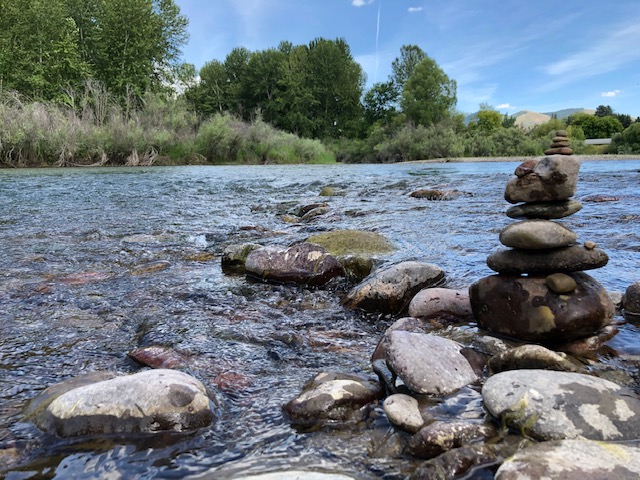Most of us have learned that pain means there’s something wrong in our body, and when there’s not, we may be told “it’s in your head.” Fortunately, we know better now. You can experience pain without damage in the body, and you can have tissue damage without pain. That’s because the experience of pain is something your brain gives you to protect you when it perceives you are in danger. And your brain makes that “decision” based on everything it’s aware of (even if you aren’t!) – including what’s happening in your body, thoughts, emotions and actions.
The great thing is that we also now know that we can change pain by learning about how it works and changing the way we think about pain and movement. That’s not just new-age wishful thinking – it’s cutting edge neuroscience! How we think about pain, fear of pain and what we do or don’t do because of that can actually cause, maintain or exacerbate pain, or it can decrease or eliminate pain.
Pain can take over your life – but you can take back control. Neuroscience and Alexander Technique give people living with persistent pain hope for recovery from pain!
Here are some things you can do to reduce pain:
1. Find your baseline and move
Movement is almost always the best thing you can do for pain. When we are inactive, not only do muscles become deconditioned, the fear of moving grows, so the body tenses up, leading to bracing and more pain. Figure out how much you can move without pain and start from there, adding a little bit every day.
2. Pay attention to how you move … and sit and stand
How you hold yourself and move matters. Start questioning if you are working against yourself to move, sit or stand. The biggest movement problems tend to revolve around restricting movement in some way. Reflect on where you might be holding parts of your body tightly. The Alexander Technique principles of thinking up and out help to decompress. Schedule a private session, join a Mindful Movement or Elasticity at Any Age group class to learn how to free up your body. Improve balance and reduce your fear of falling by taking the Balance class.
3. Pause
Use conscious rest (here’s how) to quiet mind and muscle activity. Practicing conscious rest regularly turns down habitual tightening of muscles that you may not even notice.
4. Learn more about your body
Pain decreases when our internal body map improves. The body map can become imprecise for lots of reasons, so the more you practice awareness of your body in movement in space, the better you will feel.
5. Get regular sleep
Lack of regular hours of sleep is another risk factor for persistent pain. Device screens decrease the melatonin in your body that helps you to sleep, so turn devices off a couple hours before you plan to sleep.
6. Figure out your triggers
Pain does not equal damage in your body. All kinds of things trigger the “pain meeting” held in your brain by parts of your brain involved in memory, movement, emotions (especially fear and anxiety), hearing, seeing, sensing, stress and more. Your mission, should you choose to accept it, is to start figuring out what those things are!
7. Change your self talk
Your brain hears everything you say! Don’t let what you say be one of those triggers for pain. If you’re telling yourself you’ll just have to live with your pain, your brain’s going to get more alarmed and give you more pain for your efforts. Don’t think of it as putting a positive spin on pain. Think of it as changing the information your brain gets before it holds a pain meeting!
Support from a coach and a group of people sharing their experiences help tremendously with the process of getting out pain and getting back to moving. If you’re experiencing persistent pain, you can join the Mindful Movement for Persistent Pain class from anywhere, because it’s live online! See below for more gentle Alexander-based movement classes you can do online or in-person, like Balance, Mindful Movement and Elasticity at Any Age. (Sign up for classes and DiscoverEase memberships at https://my-site-109208-104020.square.site/.)
Here’s what some clients have to say:
“This course helped me learn ways to lessen my experience of pain and things I can do to keep from having pain in the first place. This is a very interesting and I think effective way to deal with pain.”
– Thomas
“Back pain reduced 90%. Migraines reduced 90%. Neck and shoulders pain reduced 80%. Breathing improved 95%! Mindfulness improved 90%! Alexander is the gift that keeps on giving. I came for back pain but lost my migraines! AND have seen improvement in mood and health as I invite myself to find ease. I have become more aware and mindful of my body, which has led to ease of mind! Truly a mind, body, spirit technique.”
A.S.
“Since I’ve started doing this (Alexander Technique-based Mindful Movement), parts of my body that were hurting just stopped hurting. The things that we’re doing are simple, but they’re very profound.”
Tony
Wishing you a healthy summer!
Mari
DiscoverEase in Movement


Recent Comments